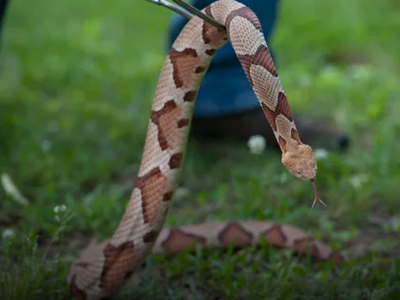Encountering an aggressive copperhead snake in January is pretty rare in most areas, but getting bit by a copperhead that was hiding in a tree is unheard of! Or so folks in Mississippi might think… until this recently happened to a hunter. It's the stuff of nightmares!
Last month, Mr. Hardy was taking the last of his dog pack back to his truck one evening when he encountered a flooded ditch. He found a narrow spot where he could jump across. When he leaned forward to jump, he felt a severe pain on th e left side of his head. At that moment, he had no idea what had hit him, until he shined his light on a branch near his head and saw something he never expected— a snake coiled up on a tree limb about six feet off the ground. Startled by the flashlight, the snake struck at the hunter again and fell out of the tree.
e left side of his head. At that moment, he had no idea what had hit him, until he shined his light on a branch near his head and saw something he never expected— a snake coiled up on a tree limb about six feet off the ground. Startled by the flashlight, the snake struck at the hunter again and fell out of the tree.
Mr. Hardy was hunting with a friend and both identified the snake as a copperhead, which is common in Mississippi and venomous. Both hunters grabbed the dog and loaded her and their gear in the truck. Even though that took only a couple of minutes, Hardy was already feeling the effects of the bite. "It was a lot of severe burning. By the time I got in the truck the burning was spreading. It started spreading rapidly, the swelling,” he said. Amazingly, the two hunters didn't panic. They called the closest hospital so that the emergency medical team would be prepared when he arrived. Five vials of Crofab, an antivenom, was administered at that local hospital, and then Mr. Hardy was airlifted to a medical center in Jackson. After a day of hospital care, doctors agreed to release him because his wife is a nurse practitioner and could monitor his condition at home.
“Copperheads are basically terrestrial snakes, but it's been known that they will climb trees,” commented a local herpetologist. “One of the more common times for copperheads to climb is during summers when cicadas emerge from the ground and cling to trees and bushes while they shed their shells. During that time, copperheads will climb to eat the insects.” Since the hunter was bitten in January, that obviously wasn't the case here. One theory is that this particular copperhead ended up in the tree because it was caught in flash-flooding that occurred the day before. "I'll be looking [for snakes] the rest of my life," Hardy said. "I'll get some snake boots and a hat, I reckon."
If that scary incident wasn’t enough, a couple of weeks prior to that, another hunter, Mr. Ginn from Lexington, was trapped in a small hunting blind with a rattlesnake. It was a warm morning with temperatures in the 60s, so seeing a snake wasn’t too surprising, but hearing a rattling sound and then discovering a rattler next to his boot in a four foot by four foot space with no way to escape was more than alarming! With the commotion of the hunter jumping on his chair, the snake became more agitated and was striking at the chair each time it moved. Ginn took aim through his scope at the snake's head, fired, and missed. Scopes are great tools for shooting at long distances, but at a couple of feet, not so much. The hunter then put the barrel close to the snake's head as the snake was striking at it and fired. The rattling stopped, the snake was dead, but Ginn’s ears rang all day from firing a high-powered rifle in a metal building no larger than a typical public restroom stall "I shot twice. There's no telling what it would have measured on a decibel meter.” The snake measured about four and a half feet, had eight rattles, and its girth was larger than a canned drink.
Copperheads and rattlesnake are only two types of venomous snakes found in Mississippi. The cottonmouth is another. A local snake expert said Mississippians should not be surprised to see snakes at any time of year in the South. They don't truly hibernate. Snakes do something called brumate, at which time they're semi-active. They move around a little. Because of that, and combined with Mississippi's mild winters, you can find snakes in Mississippi twelve months of the year. Obviously these unfortunate snake encounters are not the norm, and should not keep people out of the woods. But keep in mind that in the South, snakes are active year-round, so protect yourself as best as you can by being very aware of your surroundings and wearing snake gaiters or snake proof boots.